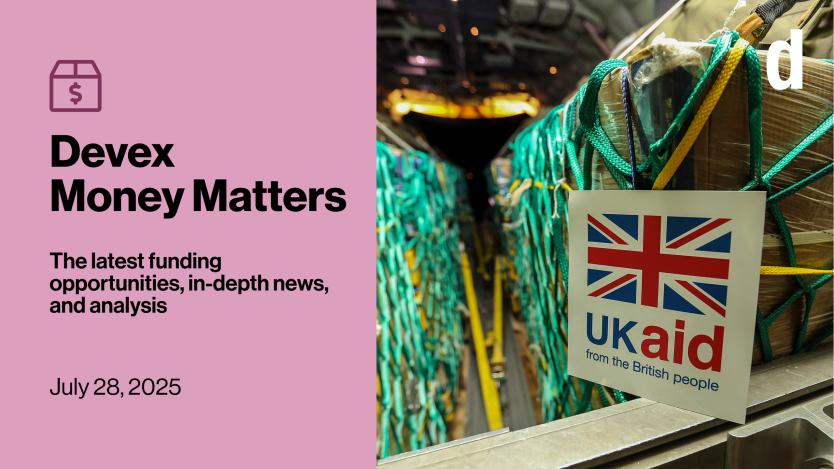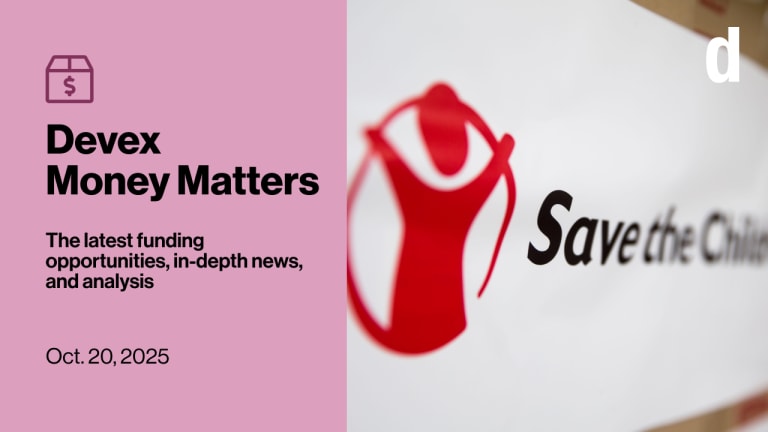
By 2027, the United Kingdom would have cut its aid budget by 40%, relative to gross national income. Now, the country’s main development agency has shed some light on where the cuts will be felt the hardest. This year alone, aid to Africa is falling by 12%, and in the years to come, those drops will be even steeper.
Also in this edition: A primer on Australia’s ODA spending, a grim projection for global health spending, and some bright — and much needed — light from foundations.
Devex is taking a companywide break next week. We’ll be back with our next edition of Money Matters on Aug. 11.
+ Are there topics you want to read more about in Money Matters? We want your feedback.
Death by a thousand cuts
Earlier this year, the United Kingdom announced it would slash its aid spending to 0.3% of its GNI by 2027 — a 40% drop from its allocation in the last calendar year.
Now, the country’s Foreign, Commonwealth & Development Office, or FCDO, has started to flesh out exactly what those cuts will mean — and this year alone, its support for Africa will drop by 12%.
It’s part of a phased approach to get to that 40% drop, Business Editor David Ainsworth reports. This year, FCDO will cut its aid by over 6%. Next year and the following, steeper cuts will follow. But for now, the agency’s annual report shows a drop from around £9.3 billion to £8.7 billion from this year to last, with tough blows to some countries suffering the worst humanitarian crises — including the occupied Palestinian territories and Sudan, which will see drops of 21% and 18%, respectively.
Meanwhile support for women and girls is falling by 42%, and health is dropping by 46%
“The world’s most marginalised communities, particularly those experiencing conflict and women and girls, will pay the highest price for these political choices,” Gideon Rabinowitz, the director of policy and advocacy at Bond, tells Devex. “At a time when the US has gutted all gender programming, the UK should be stepping up, not stepping back.”
Read: What FCDO will spend its money on this year
Funding activity
We publish tenders, grants, and other funding announcements on our Funding Platform. Here are some of those viewed the most in the past 10 days.
The African Development Bank has approved a $19.93 million grant to improve access to basic social services for underserved communities in Gambia.
The Asian Development Bank is looking for companies to work on the rehabilitation and improvement of rural roads in Sri Lanka.
The European Bank for Reconstruction and Development is lending $65 million to support the modernization of fertilizer production in Georgia.
The Inter-American Development Bank has approved a $1.2 billion loan for fiscal and regulatory reforms in Argentina.
The World Bank is seeking consulting services for a study on how people who are displaced and host residents interact in local labor markets in Ethiopia.
+ Try out Devex Pro Funding today with a free five-day trial and explore funding opportunities from over 850 funders with the data analysis and industry intelligence you need to win them, in addition to all our exclusive analyses and news content.
Ailing support
Speaking of funding cuts, let’s turn to the World Health Organization, an agency that’s been shaken by the Donald Trump administration ever since the U.S. president’s first day in office.
On Jan. 20, Trump pulled out of WHO — and six months later, official development assistance, or ODA, for health is expected to hit a decade low. This year, health spending is projected to drop by up to 40% compared to 2023 levels, WHO projects: from over $25 billion to around $15 billion in just two years. That’s even lower than global health spending in 2015.
That’s not all due to the U.S., Senior Reporter Jenny Lei Ravelo writes; several countries in Europe have reduced their spending too. But still, the U.S. used to be the world’s largest sovereign donor to health, and its fundamental rethink of development aid is changing the entire global health sector.
“This means … countries need to spend more on health. Full stop,” WHO’s Kalipso Chalkidou tells Jenny. “They need to prioritize domestic public spending on health.”
Read: WHO projects up to 40% cut in health aid in 2025
Down Under target
Meanwhile, Australian aid has remained relatively consistent, totaling around $3 billion for the last several years. These days, steady funding cannot be overstated — but the reality is, Australia has been contributing less and less compared to its gross national income since 2019.
That year, the country contributed just 0.22% of its GNI to ODA. It’s a figure far from the 0.7% United Nations target, but still more than Australia’s ratio four years later: In 2023, the Aussies spent just 0.19% of their GNI on aid, according to our data analyst Miguel Antonio Tamonan.
The majority of that spending went to four areas, including climate action, disability equity and rights, gender equality, and humanitarian aid, with three-quarters of Australian aid going to the Indo-Pacific region. Papua New Guinea was the largest recipient of those funds, followed by Indonesia, the Solomon Islands, and Fiji.
While confirmed data from the Organisation for Economic Co-operation and Development stops at 2023, preliminary figures from the country’s latest budget seem to follow the same through lines for this year, with Australia estimated to be spending around $3.3 billion from 2025 to 2026.
Read: Australian aid — a primer (Pro)
All in, then all out
So yeah — things are tough. But there are some development players that are still showing their support for the sector. That includes the Gates Foundation, which recently announced it will be doubling its giving to $200 billion until it closes its doors in 20 years.
“It’s forcing us to be much more rigorous about what is our true comparative advantage,” said Mark Suzman, the chief executive officer of the Gates Foundation, in a recent Devex Pro briefing.
For Suzman, that means focusing on outcomes and sticking to the foundation’s core priorities: maternal and child health, and minimizing preventable deaths; eradicating infectious diseases such as polio, malaria, tuberculosis, and HIV; and economic mobility and opportunity. It also means changing the partners the foundation works with. Suzman added that over the next five to 10 years, there will be “significant turnover and change.”
“If you’re going to be a partner with the Gates Foundation, expect us to be a very engaged partner. We are not a hands-off partner, and we’ll just be transparent and honest about that,” Suzman said. “We think that can still be a very trust-based healthy dialogue … but that’s our nature and model.”
Read: Gates CEO on what the next 20 years hold, and what it means for partners (Pro)
Interested in learning more about aid and funding? If you’re a Devex Pro member, you can sign up to three briefings this week. On Wednesday, at 2 p.m. ET, we’ll be speaking with Dr. Neil Buddy Shah, CEO of the Clinton Health Access Initiative.
On Thursday, at 9:30 a.m. ET, we’ll be looking at how to get funding from the Global Gateway, the premier funding stream from the European Union.
And on Friday, at 10 a.m. ET, we’ll be discussing African health independence with Dr. Jean Kaseya, director-general of the Africa Centres for Disease Control and Prevention.
An Africa-focused outlier
Speaking of foundations (and the Aussies) we’ve got an inside look at the Judith Neilson Foundation, a Sydney-based organization that’s on a mission to scale up its funding for Africa by more than 65%. By the end of this year, JNF will increase its support to the continent by about $6.5 million, bringing the foundation’s total spend in the region to $16.3 million while most are stepping away.
In a recent Devex Pro Funding conversation, Simon Freeman, the foundation’s chief executive officer, outlined the rationale behind this expansion, and shared how the foundation is evolving its geographic and thematic strategies. Freeman also shared some advice for those seeking to partner with JNF, which typically gives grants between $200,000 to $2.5 million over five years or less.
So, what is the foundation looking for in its new partners? First on the list is strategic alignment — not just with JNF’s own priorities, but with those of the country where the project will be located. Second is in-country leadership and a grounded understanding of country context. And third, among other factors, is a demonstrated track record of long-term, systemic outcomes.
Read: How aid cuts drove one foundation to step up its funding to Africa (Pro)
+ Interested in more funding coverage? Explore our funding insights page. If you aren’t a Devex Pro member yet, start your 15-day free trial now to access all our exclusive reporting, analyses, events, and more.
Sign up to Money Matters for an inside look at the biggest stories in development funding.








